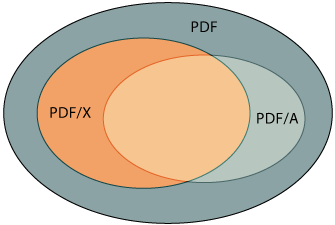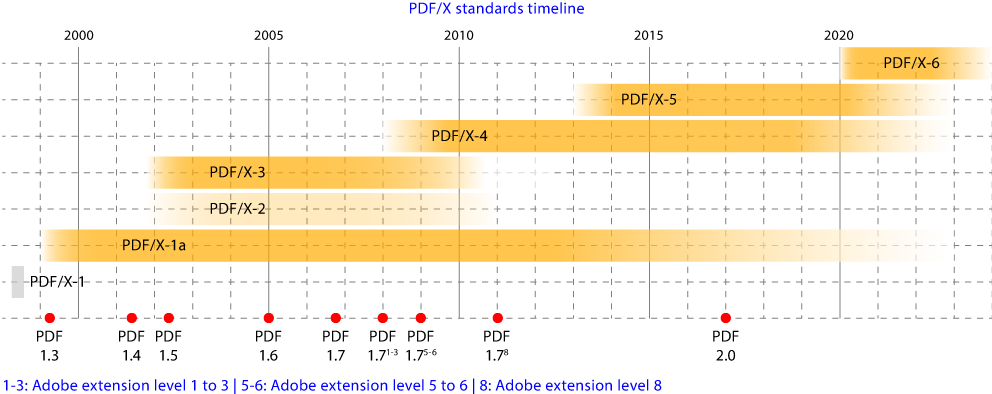What are PDF/X standards
The PDF/X standards are a set of rules that specify what a PDF intended for print can and cannot contain. In addition to complying with these rules, a PDF/X identifies itself as such with an internal mark. Its main objective is to print with as little printer intervention as possible (blind exchange: what is delivered is printed as it comes).
As the PDF format is extremely versatile, PDF/X was developed to restrict the thousands of problems that a freewheling PDF could cause in print. Since only a few of the possibilities of a PDF are needed in print, what PDF/X does is to restrict what a document can contain and how. In addition to these restrictions, PDF/X imposes some obligations.

These standards are a limited subset of the features that a PDF can contain. In that sense they are similar to PDF/A.
There is no single PDF/X variant. It is a standard that has evolved over time and there are many different standards and levels. But in all of them, the philosophy is that the document must be ready to print with as little intervention and guesses from the receiver as possible.
What the PDF/X standards don't do
In printing there are many things that are not good or bad, but that depend on the characteristics of a particular job and the user's choice. Therefore, not everything is set under control and many things are left to the will of the PDF creator, who is responsible for sticking to the necessary specifications. The main aspects that are not controlled are:
-
The inclusion of a correct bleed is not mandatory (there are many works that do not have any bleed).
-
There is no minimum, maximum or optimum resolution.
-
No maximum ink content (TAC) is imposed.
-
The use of special inks or varnishes is not restricted.
-
No page size is imposed.
-
No restrictions are set over the quality of fonts, images or graphics.
Therefore, no PDF/X is a silver bulet that prevents poor quality or unexpected results.
Beyond PDF/X
There are some initiatives that try to deal with these circumstances, e.g. "PDF/X plus" or the specifications published by the GWG, but PitStop does not covers them and they fall outside the scope of this page (they are not standards).
Using PDF/X standards as a basis, these specifications go a bit further to address the needs of given market sector. So, for example, the 2015 GWG specifications for magazine advertisements state that colour images must have an effective resolution of at least 224 dpi.
What happens to what is forbidden
When a document to be converted to PDF/X has features that are not supported at a certain level, the usual device is to convert the inappropriate elements to make them permissible. For example, OpenType fonts are often passed as PostScript Type 1 fonts or transparencies are flattened so that they disappear.
Warning: These adaptation procedures are a degradation of original features and sometimes their application has undesirable effects that become visible. Therefore, whenever possible, it is best to avoid them by using a higher level of the PDF/X standard that supports them.
PDF/X levels and revisions
To take advantage of the evolution of commercial printing technology, PDF/X standards have evolved over time. Therefore, they have several levels, indicated by a hyphen and number (e.g. "PDF/X-3" or "PDF/X-6"). Each level may have one or more revisions (minor changes), indicated by a colon and the year of publication (e.g. "PDF/X-3:2002" or "PDF/X-4:2008").
This nomenclature makes it possible, for example, to know exactly which rules a PDF/X-1a:2001 complies with or how it should be modified to comply with them.
In addition, a standard may have a variant for a given usage. This is the case of "PDF/X-2p", "PDF/X-4p" or "PDF/X-6p", where the "p" indicates that for their reproduction they require external elements (images or colour profiles). These "p" variants are intended for specific markets (packaging) or closed flows where many documents use the same resource (e.g. a limited set of colour profiles) and linking is more practical than embedding.
Not all standards or revisions have been used. The first one, "1.0", which appeared in 1999, did not become established as a standard, for example, and the PDF/X-2 versions did not have any real trajectory either.
Other levels that have had more or less use have been superseded by later ones and their use is discouraged unless the use of obsolete machinery prevents their abandonment (this is the case of PDF/X-1a, for example).

These are the existing PDF/X levels and revisions:
-
PDF/X-1:1999 (no llegó a desarrollarse como estándar).
-
PDF/X-1a (Everything flattened and in CMYK or spot colours. Standard obsolete for older machinery).
-
PDF/X-2 y PDF/X-2p (Focused on packaging and workflows with external elements, it never took off (ISO 15930-5). Its heirs are the PDF/X-5 versions.)
-
PDF/X-3 (Everything flattened and CMYK and spot, but RGB and device independent colours are supported. Standard superseded by PDF/X-4)
-
PDF/X-4 (with PDF/X-4p variant). (native tansparencies and device-independent colours are supported. It is the prevailing and generally recommended standard).
-
PDF/X-5 (with PDF/X-5g, PDF/X-5pg y PDF/X-5n variants) (Limited-use standards centered on packaging).
-
PDF/X-6 (with PDF/X-6p y PDF/X-6n variants) (PDF 2.0 applied to PDF/X. In process of implementation by manufacturers).
The summary on each page of a particular standard is of a general one and does not go into the finer details. To find out about them, it is necessary to purchase the relevant publications from ISO, which is currently the body in charge of these standards.
[© Gustavo Sánchez Muñoz, 2025] Gustavo Sánchez Muñoz (also identified as Gusgsm) is the author of the content of this page. Its graphic and written content can be shared, copied and redistributed in whole or in part without the express permission of its author with the only condition that it cannot be used for directly commercial purposes (that is: It cannot be resold, but it can form part as reasonable quotations in commercial works) and the legal terms of any derivative works must be the same as those expressed in this statement. The citation of the source with reference to this site and its author is not mandatory, although it is always appreciated.